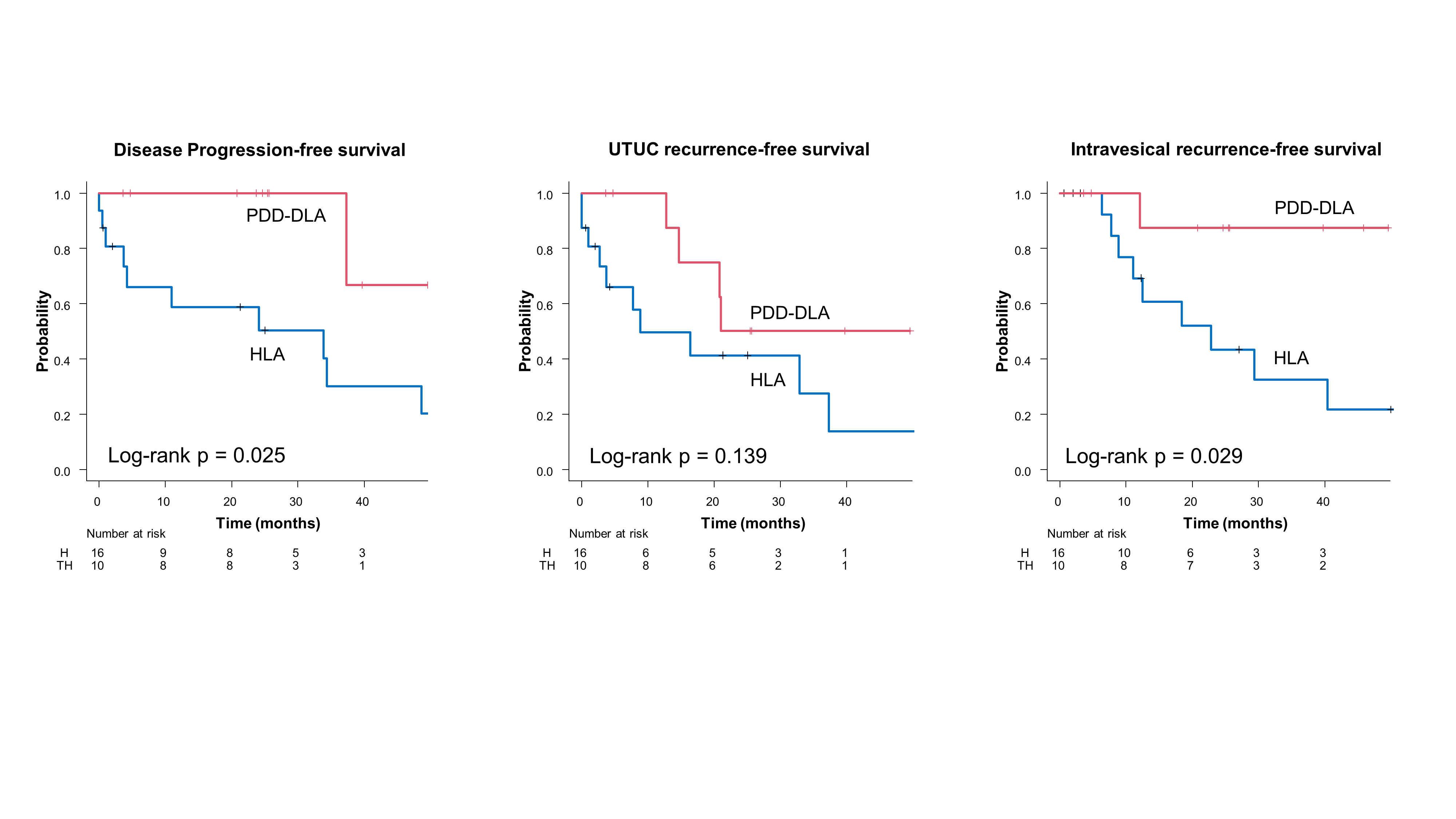Back
Poster, Podium & Video Sessions
Moderated Poster
MP40: Bladder Cancer: Upper Tract Transitional Cell Carcinoma I
MP40-08: Novel Endoscopic Management for Localized Upper Urinary Tract Carcinoma using a Photodynamic Diagnosis-guided Dual Laser Ablation Technique: 3-year Follow-up Results
Sunday, May 15, 2022
8:45 AM – 10:00 AM
Location: Room 225
Takashi Yoshida*, Tadashi Matsuda, Chisato Ohe, Hidefumi Kinoshita, Osaka, Japan
- TY
Takashi Yoshida, MD
Kansai medical university
Poster Presenter(s)
Introduction: Radical nephroureterectomy (RNU) is the gold standard treatment for localized upper tract urothelial carcinoma (UTUC); however, ureteroscopic surgery (URS) has become a more common treatment option for low-risk cases ( <2 cm, low grade, and low stage) or imperative cases (solitary kidneys, bilateral tumors, or impaired renal function). Our group has demonstrated URS using the photodynamic diagnosis-guided dual laser ablation (PDD-DLA) technique (Yoshida T et al. Eur Urol Open Sci. 2021). In this analysis, we evaluated its long-term efficacy in patients with UTUC undergoing PDD-DLA. This study aimed to compare the efficacy of PDD-DLA versus the conventional holmium laser ablation (HLA) to evaluate oncological outcomes.
Methods: The study included ten consecutive patients with UTUC who underwent PDD-DLA between 2017 and 2019, and 16 consecutive patients who underwent HLA between 2006 and 2016 as a historical control group. The primary endpoint for the study was disease progression (defined as a relapsing tumor that could not be continued with a conservative approach and/or distant metastases). Secondary endpoints were to evaluate UTUC recurrence-free survival (RFS) and intravesical recurrence-free survival (IVRFS). The Kaplan-Meier method with log-rank test was used for survival analysis.
Results: The baseline characteristics were well balanced between the PDD-DLA and HLA groups in terms of tumor size, tumor grade, and multifocality. The disease progression-free rate was significantly higher among patients treated with PDD-DLA than in the HLA group (median survival: not reached vs. 33.9 months; p = 0.025). The UTUC-RFS rate was not significantly different between the two groups (median survival: 21.0 vs. 8.8 months; p = 0.139), The IVRFS rate was better in the PDD-DLA group when compared with those treated with HLA (median survival: not reached vs. 22.9 months; p = 0.029).
Conclusions: PDD-DLA was beneficial as a kidney-sparing surgery for UTUC with a 3-year follow-up. Furthermore, PDD-DLA prevented IVR when compared with the conventional method.
Source of Funding: None

Methods: The study included ten consecutive patients with UTUC who underwent PDD-DLA between 2017 and 2019, and 16 consecutive patients who underwent HLA between 2006 and 2016 as a historical control group. The primary endpoint for the study was disease progression (defined as a relapsing tumor that could not be continued with a conservative approach and/or distant metastases). Secondary endpoints were to evaluate UTUC recurrence-free survival (RFS) and intravesical recurrence-free survival (IVRFS). The Kaplan-Meier method with log-rank test was used for survival analysis.
Results: The baseline characteristics were well balanced between the PDD-DLA and HLA groups in terms of tumor size, tumor grade, and multifocality. The disease progression-free rate was significantly higher among patients treated with PDD-DLA than in the HLA group (median survival: not reached vs. 33.9 months; p = 0.025). The UTUC-RFS rate was not significantly different between the two groups (median survival: 21.0 vs. 8.8 months; p = 0.139), The IVRFS rate was better in the PDD-DLA group when compared with those treated with HLA (median survival: not reached vs. 22.9 months; p = 0.029).
Conclusions: PDD-DLA was beneficial as a kidney-sparing surgery for UTUC with a 3-year follow-up. Furthermore, PDD-DLA prevented IVR when compared with the conventional method.
Source of Funding: None


.jpg)
.jpg)